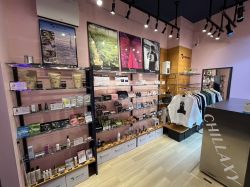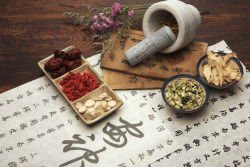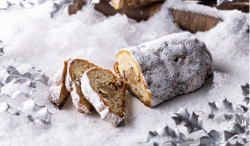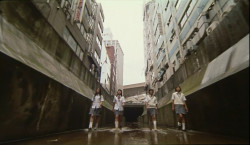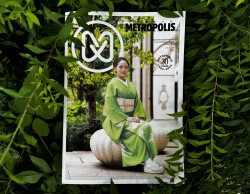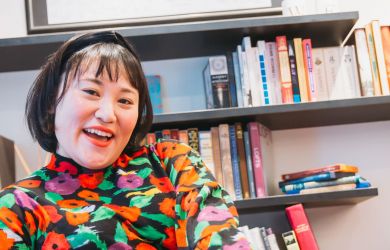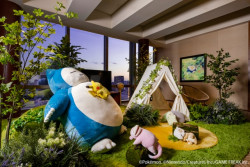
July 10, 2008
Long Live the Queen
TV host Charles Ayres scours the city for his prince
By Metropolis
Charles Ayres gets the scoop on the best of gay Tokyo
Some so-called Asian specialists would have you believe that Japan, as much of Asia, stands as a gay wasteland, a place where gay women and men hide their stripes and suffer through a dreary life of closeted ennui and tearful solitude (outside Thailand, anyway). Balderdash! Poppycock! In Tokyo, people in the know realize that the 21st century offers a cornucopia of gayness that goes far beyond Ni-Chome.
Certainly you have heard of Shinjuku Ni-Chome. Tokyo’s gay life epicenter is situated on a several-block radius about ten minutes from the east exit of JR Shinjuku station. Even here, however, gays can be as discriminatory as the straights, so gaijin get relegated to a few dozen foreigner-friendly establishments. The English sign outside one popular bar in Ni-Chome says, “_____ Bar is for Japanese and Asian [sic]. Thank you.” In other words, “We don’t like your kind.” We may shake our heads and say “Tsk-tsk,” but as minority gays in America will tell you, the Western gay world can be just as prejudiced. The Japanese just tend to be more up front about it.
Advocates Café (www.advocates-cafe.com; 2-18-1 Shinjuku) is a great place to start your evening. This pub on the corner of the main drag can easily be spotted by the swarms of people coming in and out, especially on weekend nights. Gather your crew while swishing down cosmopolitans before venturing into “The Bermuda Triangle”of foreigner-friendly establishments: GB (http://gb-tokyo.tripod.com; 2-12-3 Shinjuku), Arty Farty (www.arty-farty.net; 2-11-7 Shinjuku) and Dragon Men (2-11-4 Shinjuku; 03-3341-0606). We call it The Bermuda Triangle because lots of foreign queers go in, but with all the cute J-Boys around, you might never come out! Dragon Men recently underwent a complete facelift, going from a grungy dungeon-like club to a swish New York-style lounge bar. Muscle-y manager Takaya-san says the redesign “reflects the change in Tokyo gay life from hidden and underground to more open and cheerful,” and notes that women are welcome as well.
Arty Farty and another handful of places offer decent dance spaces, but the musical repertoire rarely ventures far from Britney and Kylie. If listening to one more Mariah Carey remix will make your head explode, it’s time to leave Ni-Chome and go to the real clubs. Ageha, with its pool, many rooms and name value, offers Shangri-La (www.ageha.com/gn), a large-scale event with a variety of music such as house, hip-hop and electro. The Shangri-La parties come and go once every few months, so you have time to get buff and pick the perfect outfit for the next one in October. Venerable house party The Ring has been pulling in a more intimate crowd since 1991. Organzier Lamont Raymond says, “We don’t offer the biggest party, but we offer the most fun party.” Ring takes place at Warehouse in Azabu-Juban (www.warehouse702.com, 03-6230-0343) the last Saturday of every month, and if you get there before midnight, you only pay ¥2,000 (as opposed to ¥4,000 after the witching hour). Although not strictly gay, the electro events at Velours (www.velours.jp; B1-6-4-6 Minami-Aoyama, Minato-ku) and Le Baron (www.lebaron.jp; B1-3-8-40 Minami-Aoyama, Minato-ku) in Aoyama often draw the fashion-forward gays of Tokyo.
Forget Year of the Rat—2008 definitely is the Year of the Lesbian. The US show The L Word has been a huge TV and DVD hit in Japan. Sapphic sweeties here like to call themselves bians, which Hiroko, manager of Ni-Chome’s newly opened lesbian hotspot Bar Motel #203 (www.bar-motel.com; 2-7-2 Shinjuku), tells me, “sounds less harsh than ‘lesbian.’” (Other lesbian friends of mine point out that it also sounds like the French word bien, as in “good.” Tres chic, non?) For foreign lesbians, it is all about a Wednesday night party in Shibuya called Chestnut and Squirrel (http://chestnutandsquirrel.com)—or “Kuri to Risu” (get it?!?).
Seeing as I am knocking on the Old Maid door at the ripe age of 30, I decided to venture out into Ni-Chome to survey what the youngsters had to say about dating. After conducting a completely biased, politically incorrect poll of 50 gays, lesbians, drag queens and fabulous straights (to borrow a line from New York gay magazine HX), I got the 411 on where the kids hang out.
By far, the most popular gay-friendly restaurant turns out to be Aoyama’s Las Chicas (www.vision.co.jp; 5-47-6 Jingumae, Shibuya-ku). Shibuya’s The Pink Cow (www.thepinkcow.com; B1-1-3-18 Shibuya, Shibuya-ku; ) welcomes people of all persuasions, while the glitterati love Roppongi’s 57 (www.fiftyseven.co.jp; B1F-4-2-35 Roppongi, Minato-ku). People in the mood for a bite in Ni-Chome head over to CoCoLo Café (www.akiplan.com/cocolo-cafe; 2-14-6 Shinjuku), located near Advocates. Be forewarned that these are not “gay restaurants” per se, but places that gays might feel at home dining.
Without silver screen legends like Judy and Marilyn, I believe that homosexuals would simply keel over and die (tell that to the Christian right). That’s why date spots mentioned in the survey included movie theaters such as Roppongi Hills’ Virgin Toho Cinemas (www.tohotheater.jp/theater/roppongi) and Shinjuku’s newly opened Wald 9 (www.wald9.com; 9-14F-31-26 Shinjuku). When tired of hackneyed Hollywood fare, the boys and girls catch indie flicks over at Cinema Rise in Shibuya (www.cinemarise.com; 13-17 Udagawacho, Shibuya-ku). Several gays mentioned a movie theater in Ueno, but Lord have mercy, I can’t tell you what goes on in there without blushing.
Ready to go on a walk with your J-Boy or -Girl honey? Shinjuku Gyoen (www.shinjukugyoen.go.jp) topped the list as a nice gay place to stroll hand-in-hand. For gays who want to show off their gym-toned bodies, the beaches of Shonan got top marks. The Saikyo (train) line and Francfranc furnishings store (www.francfranc.com) got mentions as places that queers might unexpectedly be in good company.
So, you’ve scoured the dating scene, snagged yourself a hot J-Boy or J-Girl, and are looking to settle down. Conventional wisdom says that the areas of the city with highest ratio of gay inhabitants are Shinjuku, Nakano and Akabane. Older gays often mention Ueno area as a hub. So if you are timid about visiting a real estate agent as a gay couple, head to these areas; it is less likely you will be the first ones.
So, naysayers be gone—gay London and New York might be more socially progressive in some ways, but gay Tokyo is here and happening. Play hard. Play safe. And happy hunting!
The 17th Tokyo International Lesbian & Gay Film Festival
Featuring three dozen films from around the world (many of which will be making their international premiere), the Tokyo LGFF takes place in Shinjuku and Aoyama July 11-13 and 17-21. The festival also includes parties, talks by filmmakers and other events. See
www.tokyo-lgff.org for complete info (English and Japanese).
8th Tokyo Pride Parade
The Tokyo Pride Parade, an annual event usually held in August, has been postponed until May 2009. Past events have included symposiums, speeches, a flea market, live music, DJs, dancing, food and drinks. For schedule and route updates, keep your eye on www.tokyo-pride.org (Japanese); for details about last year’s event, see www.parade.tokyo-pride.org/6th/index.shtml (English and Japanese).
Bian Lesbian
Gei Gay male
Kuma-kei Bears (beefy, hairy guys)
Ikanimo-kei Stereotypically Gay (tan, muscles, well-trimmed facial hair)
Okama Fairy (derogatory)
Dondake Bitch, please! (Give me a break) CA

